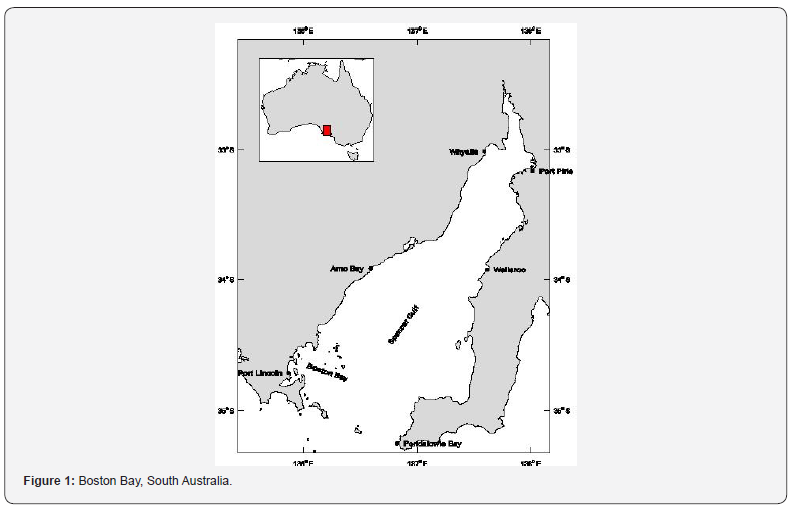The Physics Governing the Operation of Cages in an Aquaculture Farm: A Case Study from South Australia
John A T Bye*
School of Earth Sciences, The University of Melbourne, Australia
Submission:February 27, 2020; Published:March 19, 2020
*Correspondence author: John AT Bye, School of Earth Sciences, The University of Melbourne, Victoria 3010, Australia
How to cite this article:John A T Bye. The Physics Governing the Operation of Cages in an Aquaculture Farm: A Case Study from South Australia. Oceanogr Fish Open Access J. 2020; 11(5): 555824. DOI: 10.19080/OFOAJ.2020.11.555824
Introduction
The successful operation of fish farms is of paramount importance. This short paper summarizes the environmental physics which applies in a vertically well mixed water body in a coastal location maintained by tidal exchange, which is where most productive fish farms are located. Analytical formulae are given which are easily applied from basic oceanographic data and the fish stock which is proposed for the cages in the aquaculture farm. No specialist oceanographic knowledge is assumed for the implementation of the formulae, as is demonstrated from a case study for an aquaculture farm in South Australia.
The Parameters which Predict the Behaviour of the Fish Farm
Section 2.1: The Specification of the Well Mixed Tidal Environment
The controlling mixing coefficient for the tidal environment

Section 2.2: The Material Balance in the Aquaculture Cage
The mean concentration of material in the cage due to the fish

Section 2.3: The Stirring Velocity and the Cage Time Constant
We need now to determine the stirring velocity for the ventilated cage This can be done by considering a cage which is situated in a tidal stream of ambient concentration (co). The

The steady-state solution of this equation for the mean concentration in the well mixed cage is


Section 2.4: The Range of Material Concentration in the Cage due to Ventilation
On considering the material budget equation at the maximum, TUU= , and the minimum, 0U= of the inflowing tidal current, we also find that the concentration in the cage due to ventilation with the environment, which has a mean value of oc , ranges from ocπ to 0.
These relations enable the hydrodynamics of any aquaculture farm to be readily assessed.
Case Study for the Aquaculture Farm in Spencer Gulf, South Australia
The South Australian aquaculture farm is in Boston Bay in southern Spencer Gulf (Figure 1). The cages are situated in a water depth (H) of about 20 m, and in a semi-diurnal tidal stream amplitude, UT = 25 cm/s at Spring tide [2]. Hence from Section 2.1, at Spring tide, Kv = 30 cm2/s and the mixing time, Tv = 3.8 hrs, which is much less than the tidal period, To = 12.4 hrs, so that vertically well mixed conditions apply, which would be expected to persist throughout the tidal cycle.
In the Boston Bay aquaculture farm, there are 150 cages of diameter (D = 40 m) and cage depth (h = 10 m) and in the growout season about 350 t/month of nitrogen is excreted [3]. Hence the source flux of NO3/ cage is 4 g/s, and the specific flux, F = 3 10-7 kg/m3/s. The ambient concentration of NO3 in the grow out season, 4 / co = μg l [4].

For these conditions, the stirring velocity, Uc = 2.5 cm/s, the cage time constant, Tc = 395 s (Section 2.3) and the mean concentration of NO3 in the cage due to the fish farming, 120 / cm = μg l (Section 2.2), and the increase in ambient cage concentration at maximum ebb and flow over slack water is 12 μg/l, which is about 10% of the mean cage concentration (co+cm) of 124 μg/l (Section 2.4). The mean cage concentration is also about 30 times the ambient concentration. This is reflected in the sediment nutrient stores, which were more than seven times background levels during the farming season [4].
Conclusion
An expression has been derived for the cage time constant in a vertically well mixed tidal environment (A) from which the mean material concentration due to fish farming can be derived (B and C). Another expression is also presented which predicts the variability in cage concentration due to the ventilation of the cage with its tidal environment (D). Both these expressions can be readily evaluated, without the necessity for an extensive field programme as demonstrated for the aquaculture farm in Spencer Gulf, South Australia.
References
- Bye J A T (1990) Richardson Number profiles in laboratory experiments applied to shallow seas. Geophysics & Astrophysics Fluid Dynamics 51: 136-166.
- Herzfeld M, Middleton JF, Andrewartha JR, Luick J and W Leeying (2008) Numerical modelling of Boston Bay Spencer Gulf. Aquafin CRC 342: 100.
- Fernandes M, Lauer P, Cheshire A and M Angove (2007) Preliminary model of nitrogen loads from southern bluefin tuna aquaculture. Mar Pollut Bull 54(9): 1321-1332.
- Benetti D D (2000) Aquaculture of pelagic fish: Offshore cage culture of southern bluefin tuna (Thunnus maccoyii) in South Australia. Global Aquaculture Alliance: The Advocate 28-29.






























